Last updated: January 17, 2024
Imagine a horse breed so enduring that it dates back to the Middle Ages, yet today has a short lifespan. Meet the Friesian horse, a breed known for its elegant black coat and pleasant demeanor, which surprisingly has a shorter average lifespan than many other breeds.
As someone deeply immersed in the world of horses, I find this aspect of the Friesian both intriguing and important to understand. In this article, we’ll explore the lifespan of the Friesian horse, shedding light on the factors that influence their longevity and what this means for owners and breeders.
Exploring the Friesian horse lifespan takes us from their historical roots to the various factors that influence their longevity. Join me in uncovering the unique aspects of this journey and discover how we can ensure that Friesian horses live their lives to the fullest.
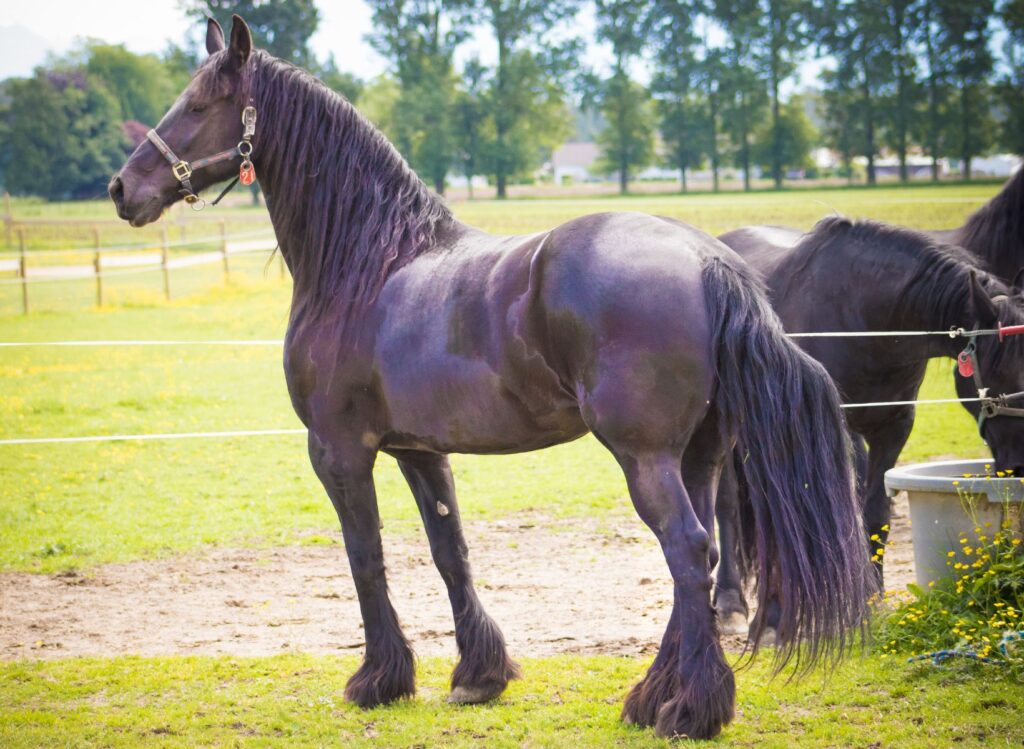
Historical Background and Breed Characteristics of Friesian Horses
The Friesian horse, with its majestic presence and unique characteristics, has a rich history intertwined with its physical and genetic traits, which are crucial to understanding its lifespan.
Historical Background
- Origins: Friesian horses originated in Friesland, a province in the northern Netherlands. Their history dates back to as early as the 13th century.
- War Horses: Historically, they were esteemed as war horses, carrying knights into battle during the Middle Ages due to their strength and size.
- Carriage Horses: In the post-medieval era, their role shifted to carriage horses, prized for their elegant gait and striking appearance.
- Near Extinction: The breed nearly faced extinction by the end of World War II, but dedicated breeding programs in the Netherlands revived it.
Distinctive Physical Characteristics
- Coat Color: Friesians are renowned for their beautiful, shiny black coat. This distinctive color is a result of a dominant gene specific to the breed.
- Body Structure: They possess a strong, muscular body, an arched neck, and a well-chiseled head with intelligent eyes.
- Mane and Tail: One of their most striking features is their long, flowing mane and tail, which add to their regal appearance.
- Height: They typically stand between 15 to 17 hands high, combining power with elegance.
Genetic Characteristics and Lifespan
- Genetic Traits: The breed’s genetic makeup contributes to its physical attributes and can influence health conditions affecting its lifespan.
- Health Concerns: Genetic predispositions in Friesians include conditions like hydrocephalus and dwarfism, which can impact their overall health and longevity.
- Lifespan Implications: Understanding these genetic factors is key to managing their health and can provide insights into their average lifespan of around 16 years.
Breeding and Preservation
- Selective Breeding: Historically, Friesians were bred for specific traits, which has led to a limited genetic pool.
- Modern Breeding Practices: Today, there is a growing emphasis on responsible breeding practices to ensure the health and longevity of the breed, including efforts to increase genetic diversity.
In conclusion, the Friesian horse’s historical background and breed characteristics are not just fascinating in their own right but are also deeply connected to their health and lifespan. Understanding these aspects provides a comprehensive view of the breed, essential for anyone interested in Friesian horses, whether as owners, breeders, or enthusiasts.
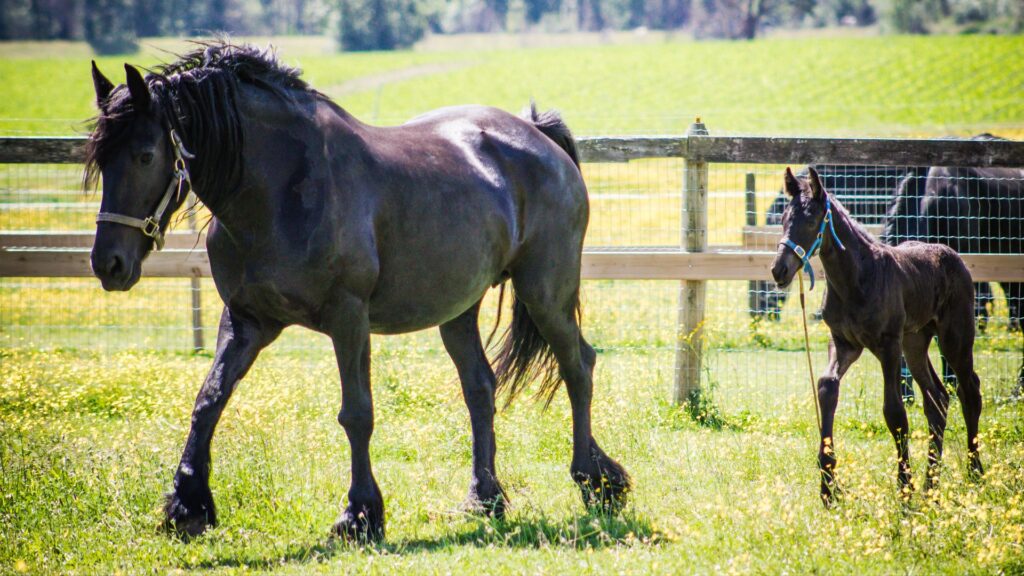
The Lifespan of Friesian Horses: An Integrated Overview
Friesian horses, with their unique beauty and shorter lifespan, present a fascinating study of genetics and longevity. Here’s an integrated look at their life expectancy, genetic traits, and how these factors interplay:
Lifespan Overview
- Average Lifespan: About 16 years, shorter than many horse breeds.
- Influencing Factors: Diet, exercise, genetics.
- Potential Longevity: Some live into their twenties with optimal care.
Bar Graph of Average Lifespan of Popular Horse Breeds: (Source)
Genetic Characteristics
- Dominant Black Gene: Almost all Friesians are black, a trait not common in other breeds.
- Distinctive Conformation: Recognizable by their long manes, arched necks, and feathered legs.
Genetics and Health
- Predisposition to Disorders: Conditions like osteochondrosis and dwarfism are more prevalent.
- Impact on Lifespan: These genetic traits can lead to health issues affecting longevity.
- Research Study: A study by Astri Olivia Herlino, titled “Genomic Analysis of Hydrocephalus in Friesian Horses,” Observed that hydrocephalus is observed more frequently in Friesians compared to other breeds. This condition is attributed to the limited genetic pool and high rate of inbreeding within the breed. (Herlino, 2013).
Research Study
- A study by Astri Olivia Herlino, titled “Genomic Analysis of Hydrocephalus in Friesian Horses,” Observed that hydrocephalus is observed more frequently in Friesians compared to other breeds. This condition is attributed to the limited genetic pool and high rate of inbreeding within the breed. (Herlino, 2013).
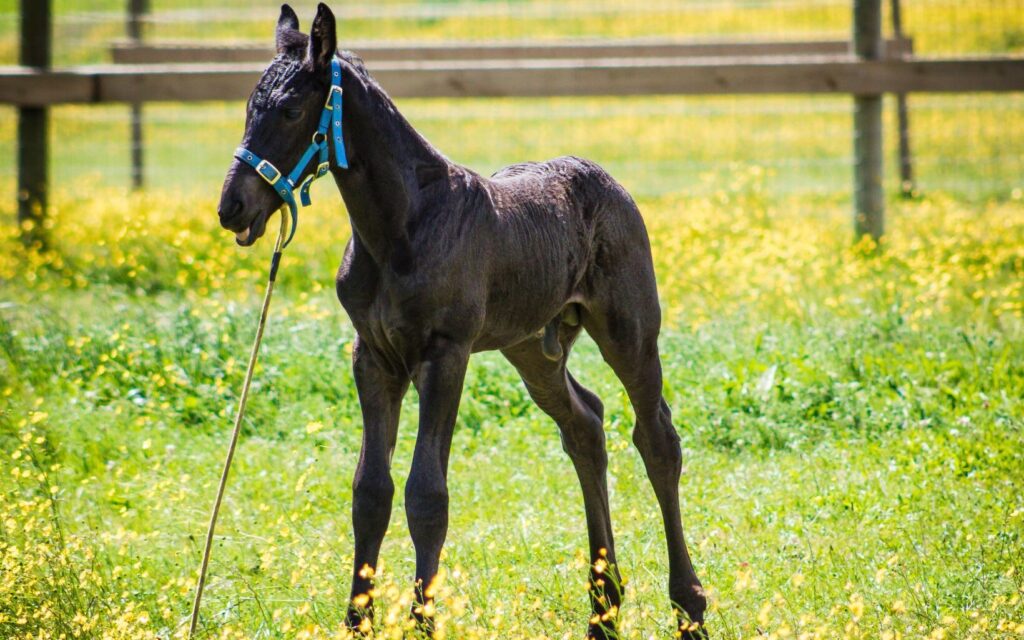
Breeding Practices
- Selective Breeding: Focus on maintaining breed characteristics; sometimes leads to inbreeding.
- Studbook Standards: Ensure breed purity and quality but may contribute to genetic health issues.
- Responsible Breeding: Prioritizing genetic diversity can enhance health and lifespan.
Physical Maturity and Aging Care
- Maturity Age: Fully mature at 5-6 years, rideable at 2 years.
- Aging Challenges: Swayed backs, joint arthritis, dental issues in older horses.
- Care Needs: Regular vet check-ups, suitable diet, farrier visits.
Lifespan Impact on Competitions
- Training for Dressage: Limited competitive years due to shorter lifespan.
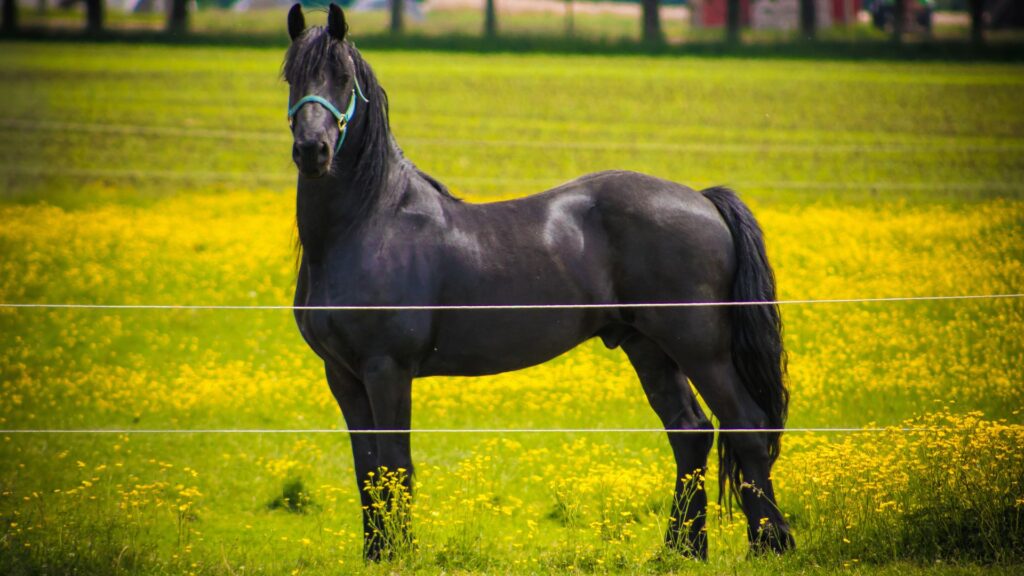
Impact of Short Lifespan on Friesians in Equestrian Sports
Friesian horses, celebrated for their striking appearance and graceful movements, have left a significant imprint in various equestrian disciplines. However, their relatively shorter lifespan, when compared to other breeds, plays a crucial role in shaping their training regimen and performance capabilities in these sports.
Friesians in Dressage
- Natural Elegance: Friesians are inherently graceful and expressive, making them ideal candidates for dressage.
- Training Timeline: Typically, Friesians begin dressage training at 3-4 years old. However, their shorter lifespan means they have fewer years to reach peak performance levels.
- Grand Prix Aspirations: Training a horse to the Grand Prix level often takes about five years without setbacks. For Friesians, this means they would be around 8-10 years old when fully trained, a significant portion of their life considering their average lifespan.
- Consideration of Lifespan: Given their shorter lifespan, the question arises whether the time, effort, and expense invested in training Friesians for high-level dressage competitions is justifiable, especially when only the most exceptional athletes, trained and ridden by skilled riders, reach the Grand Prix level.
Driving and Carriage
- Strength and Stamina: Friesians excel in driving and carriage disciplines, where their power and endurance are showcased.
- Historical Role: Their past as carriage horses makes them a favored choice for both ceremonial and recreational driving.
Show Jumping and Eventing
- Adaptability in Training: While less common in show jumping or eventing, Friesians can participate in these sports, particularly at lower levels. Training must be adapted to their physical capabilities and lifespan.
Overall Impact on Sports Performance
- Career Length: The shorter lifespan of Friesians implies a potentially abbreviated competitive career in equestrian sports.
- Health Management: Meticulous health management is essential to extend their active years in sports, including regular veterinary check-ups and a balanced diet.
- Training Approach: Considering their physical maturity and health, trainers often adopt a more measured training approach to optimize Friesians’ performance longevity.
Role of Breeders and Owners
- Focus on Athleticism: Modern breeders are increasingly emphasizing athletic abilities suitable for various equestrian disciplines alongside the breed’s aesthetic qualities.
- Owner Responsibility: Owners must be cognizant of the breed’s capabilities and limitations in sports, ensuring the horses are not overexerted.
While Friesians are a versatile and capable breed in equestrian sports, their shorter lifespan necessitates a more customized approach to their training and care in the competitive arena. With appropriate management, these majestic horses can still achieve remarkable success and add elegance and beauty to the sports they participate in.

Caring for Aging Friesian Horses
As Friesian horses enter their senior years, their care needs evolve. Here are some essential guidelines to ensure older Friesians maintain a good quality of life:
Diet Management
- Balanced Nutrition: Senior Friesians require a diet that’s easy to digest yet rich in nutrients. Incorporate senior feeds that are specifically designed for older horses.
- Fiber-Rich Foods: Ensure their diet is high in fiber to support digestive health. Beet pulp, hay cubes, and senior-specific feeds are excellent choices.
- Monitor Weight: Regularly monitor their weight and adjust their diet to prevent obesity or underweight issues, both of which can exacerbate health problems in older horses.
Exercise and Activity
- Regular, Gentle Exercise: Keep them active to maintain muscle tone and joint mobility. Light walking or turnout in a safe, enclosed area can be beneficial.
- Avoid Overexertion: Be mindful of their limits; older horses may not have the same stamina or strength as they did in their youth.
- Tailored Exercise Regimen: Consult with a veterinarian or an equine exercise specialist to develop an exercise program that suits your aging Friesian’s specific needs.
Health Monitoring and Veterinary Care
- Regular Vet Check-Ups: Schedule regular veterinary check-ups to monitor their overall health and catch any issues early.
- Dental Care: Pay attention to dental health, as older horses often have dental issues that can affect their ability to eat properly.
- Joint Care: Be proactive in managing arthritis or other joint issues. Supplements like glucosamine or chondroitin can be beneficial but consult your vet first.
- Hoof Care: Maintain regular farrier visits for hoof trimming and care, as hoof health is crucial for mobility and overall well-being.
Comfort and Environment
- Comfortable Living Conditions: Ensure they have a comfortable, safe, and warm environment. Soft bedding and shelter from harsh weather are important.
- Companionship: Social interaction is vital for their mental health. If possible, allow them to interact with other horses or animals.
Special Grooming Needs: Feathers
- Long-Flowing Manes, Tails, and Feathers: Friesian horses are famous for their long-flowing manes, tails, and feathers. The feathers and long hair on the lower legs covering the hooves require special attention.
- Preventing Skin Irritations: It’s crucial to regularly groom and clean the feathered areas to prevent skin irritations and infections. This involves careful washing and ensuring the area is kept dry and clean.
Special Considerations
- Monitoring for Disease: Be vigilant for signs of age-related diseases like Cushing’s disease or metabolic issues.
- Customized Care Plan: Each horse is unique, so tailor your care plan to your Friesian’s specific health needs and medical history.
Caring for an aging Friesian horse requires patience, attention, and a deep understanding of their changing needs. With the right care and management, these majestic horses can enjoy their senior years in comfort and dignity.

Breeding Practices and Lifespan of Friesian Horses
The breeding practices of Friesian horses have a significant impact on their lifespan. Let’s explore how these practices influence their longevity and the importance of genetic diversity and responsible breeding.
Influence of Breeding Practices on Lifespan
- Selective Breeding: Friesians are often bred for specific traits like their majestic black coat and robust physique. However, this selective breeding can lead to a narrow genetic pool.
- Inbreeding Consequences: A limited genetic pool often results in inbreeding, which can increase the risk of hereditary diseases and health issues, potentially reducing the lifespan of the breed.
- Health Risks: Conditions like hydrocephalus and dwarfism are more prevalent in Friesians due to selective breeding practices, impacting their overall health and longevity.
Below is a YouTube video about Friesian horses.
The Role of Genetic Diversity
- Preventing Genetic Disorders: Diversifying the gene pool is crucial in reducing the occurrence of genetic disorders. This can be achieved by introducing unrelated genetic lines into the breeding program.
- Enhancing Longevity: A diverse gene pool can lead to a stronger, healthier breed with a potentially longer lifespan due to reduced hereditary health issues.
Clinical Challenges in Friesian Horses
A study by S. Boerma, W. Back, and M. M. Sloet van Oldruitenborgh-Oosterbaan highlights the unique clinical challenges faced by Friesian horses. The research indicates that Friesians are more prone to certain clinical problems compared to other breeds, suggesting a genetic basis for these issues. (Boerma, Back, & Sloet van Oldruitenborgh-Oosterbaan, 2012).
Responsible Breeding Practices
- Health Over Appearance: Prioritizing health and functionality over appearance in breeding choices can lead to a healthier and more robust breed.
- Regular Health Checks: Implementing regular health screenings for breeding horses can help identify and prevent the propagation of genetic disorders.
- Breeding Program Goals: Establishing breeding programs that focus on the overall well-being and longevity of the breed, rather than just specific physical traits.
While traditional breeding practices have contributed to the unique characteristics of Friesian horses, they have also introduced challenges to their health and lifespan. Emphasizing genetic diversity and responsible breeding practices is essential for the future health and longevity of the Friesian horse breed.
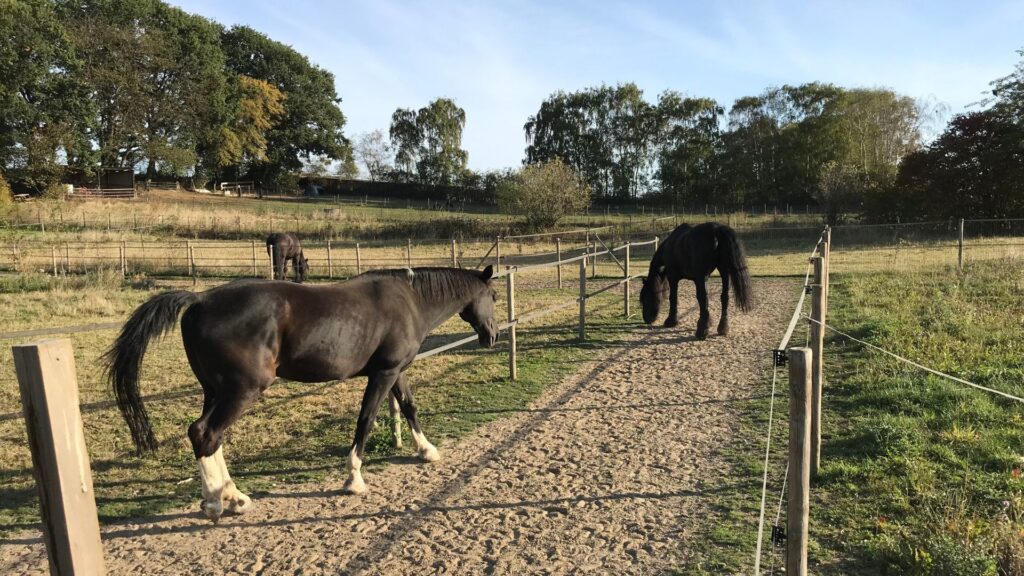
Conclusion: Friesian Horse Lifespan
In summary, the Friesian horse, a breed celebrated for its elegance and strength, typically has a shorter lifespan of around 16 years. This lifespan is influenced by factors such as genetics, health conditions, and breeding practices. Key points to remember include:
- Selective Breeding Impact: Breeding practices have contributed to genetic conditions like hydrocephalus and dwarfism, affecting the breed’s health and longevity.
- Care and Management: Proper care, including a balanced diet, regular exercise, and health monitoring, is crucial for extending the lifespan of Friesian horses.
- Role in Equestrian Sports: While Friesians excel in disciplines like dressage and carriage driving, their shorter lifespan requires a tailored approach to training and competition.
The longevity of Friesian horses can be maximized through informed ownership, responsible breeding, and attentive care. Understanding the unique needs and characteristics of this majestic breed is essential for ensuring their health and well-being throughout their lives.
Call to Action
If you’re captivated by the elegance and history of Friesian horses and want to learn more or get involved with this magnificent breed, I encourage you to explore the resources listed above. Whether you’re considering ownership, breeding, or simply wish to appreciate these majestic animals, these platforms offer a wealth of information and community connections. Dive into the world of Friesians and discover the joy and fulfillment that comes with being part of this breed’s vibrant community.
FAQs for “Average Friesian Horse Lifespan: Their Health, And Care Tips”
What is the average lifespan of a Friesian horse?
The average lifespan of a Friesian horse is around 16 years, which is shorter compared to many other horse breeds.
Are all Friesians Black?
Not all Friesians are black. While black is the most common color for Friesian horses, there are some rare occasions where Friesians can come in other equine colors, such as chestnut or bay. However, these colors are not recognized by the breed registry and are not considered acceptable for breeding.
Are Friesian horses prone to any specific health issues?
Yes, Friesian horses are genetically predisposed to certain conditions like hydrocephalus, dwarfism, and joint issues, which can impact their health and lifespan.
Where did Friesian horses get their name?
Friesian horses are named after their place of origin, Friesland in the Netherlands, where they have been an integral part of the region’s culture and history for thousands of years. They were used for farm work, transportation, and as war horses.
How can I extend the lifespan of my Friesian horse?
Extending the lifespan of a Friesian horse involves providing a balanced diet, regular exercise, routine veterinary check-ups, and attentive care to their specific health needs.
Additional Resources and Friesian Horse Associations
Friesian horse enthusiasts, owners, and prospective buyers can find a wealth of information, support, and community through various associations and resources dedicated to this magnificent breed. Here are some key organizations and online resources:
Friesian Horse Association of North America (FHANA)
- About: FHANA is dedicated to preserving and promoting the Friesian horse breed in North America.
- Services: They offer registration, breed information, events, and support for Friesian horse owners and breeders.
- Website: FHANA
The Friesian Horse Society (FHS)
- About: FHS focuses on the registration and preservation of the Friesian horse’s pure bloodlines.
- Services: They provide registration, DNA testing, and promote the breed through various events and shows.
- Website: FHS
Koninklijke Vereniging “Het Friesch Paarden-Stamboek” (KFPS)
- About: The KFPS is the original Dutch Friesian Horse registry, founded in the Netherlands.
- Services: They are responsible for the studbook, breeding, and promotion of Friesian horses globally.
- Website: KFPS
International Friesian Show Horse Association (IFSHA)
- About: IFSHA is the official United States Equestrian Federation (USEF) recognized representative of the Friesian horse.
- Services: They organize and oversee Friesian horse shows and competitions in the USA.
- Website: IFSHA
Friesian Horse Association of Great Britain & Ireland (FHAGBI)
- About: FHAGBI aims to promote and protect the interests of Friesian horses in the UK and Ireland.
- Services: They offer membership, horse registration, and organize events and shows.
- Website: FHAGBI

About the Author: Miles Henry
Lifelong Horseman | Racehorse Owner | Published Author
Miles Henry brings over 25 years of hands-on experience training and owning Thoroughbred racehorses. Raised with Quarter Horses and Appaloosas, he’s spent a lifetime learning from horses—on the track, in the barn, and in the field. Today, he runs a small but successful racing stable in Louisiana and shares real-world insights on HorseRacingSense.com, helping horse owners, fans, and bettors navigate the sport with confidence.
📚 Books: View Miles’s books on Amazon »
🎧 Podcast Guest: Animal Tales Ep. 32 |
YouTube Interview
📩 Newsletter: Sign up for racing tips and horse care advice »
🔗 Follow Miles:
Twitter |
Facebook |
YouTube


